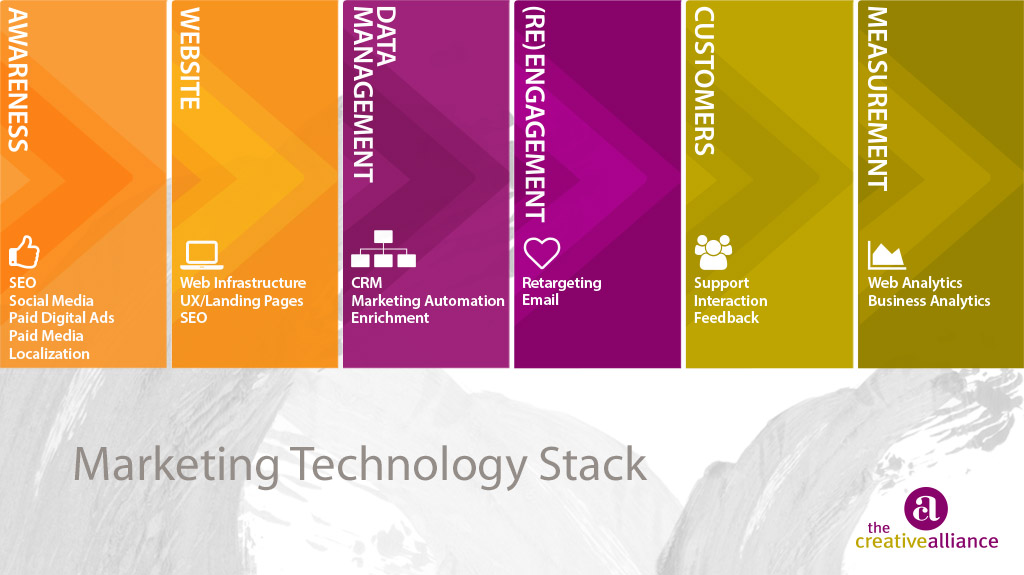Digital marketing continues to grow and evolve exponentially. So much so, that keeping up with all of the digital marketing strategies—and how they integrate with one another—can be daunting.
A Set Of Tools To Manage Your Business Big Data
The “Marketing Technology Stack” was born out of the need to graphically simplify what can be complex information. The Stack is a set of tools to manage the “big data” of your business’s inbound marketing strategy. Stack tools utilize this data to create automated, personalized, measurable marketing programs that deliver the right offers to your target audience.
Marketing stacks can be organized in many different ways. One could show a potential client’s journey as they progress through different stages of interaction; another might flow by marketing function (like lead generation, user experience, retargeting or analytics). Others could be presented as layered structures using platforms as the base with specialized elements added on top, or even as a “circuit board” schematic showing how different components are connected.
A marketing stack helps in deciding what is important, which resources to use and how to track progress and ROI. Creating a stack that works best for your organization doesn’t mean you have to spend a lot of money. The effort and tools can be scaled based on budget. This marketing stack example takes a potential customer through a funnel—from awareness of a company to website interaction, data management, remarketing, personal interaction and, finally, to measurement.
Awareness
Creating visibility and awareness is the first step toward generating clients or prospects. This top portion of the funnel includes increasing visibility of your company in search results, social media, digital ads and other paid media and webinars.
Website
Your website is the digital hub for your company. The goal is to get more traffic and leads to your website so they can be tracked and retargeted. This step of the journey encompasses your web infrastructure, user experience (UX) and usability of your website, any landing pages and SEO. It may also include localization—one or more languages.
Data Management
This includes gathering data about the potential clients who are interested in working with you. CRM, marketing automation and enrichment tools (to enhance, refine and improve raw data) belong in this step of the journey.
(Re)Engagement
Remind potential customers to come back and take action after visiting your website or searching your company as they peruse the web, Facebook or their email on multiple devices. This includes remarketing in SEM, retargeting in digital advertising and email.
Interaction
Once awareness, website visits and digital engagement have occurred, personal interaction comes next. Interaction includes contact a potential client may have with customer support or other customer communication. It also includes feedback from customers. The integration of live chat, FAQs and other quick feedback tools help build customer trust and engagement.
Measurement
When the interactions are completed, you can measure results to see what worked (ROI) or what you can change for future interactions. Measurements can include campaign and advertising data, website analytics and sales/business analytics or other statistics you may have gathered through the different stages of interaction.
Personalize Your Marketing Stack Based On Your Goals
Hopefully this marketing technology stack example can help you decide on the best digital marketing strategies to enhance your business. Does one size fit all? No. Plan around your company goals, needs and finances. Do more tools equal better data? Not necessarily. Research has shown that most companies use an average of 12 different marketing tactics. This stack includes 21 potential tools, however, it is not an exhaustive list and they may not apply to your situation.
Finally, it doesn’t help to gather a bunch of data if you aren’t going to do anything with it. It is better to slowly move into one tool or approach at a time to ensure you are making good use of the tools before adding new ones. Don’t get into “technology paralysis” just because you think you have to do it all. Utilize the digital marketing plan that works best for your company and ultimately provides the greatest ROI.
